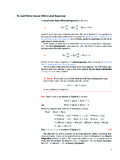Transcription of ADVANCES IN MEDICAL LINEAR ACCELERATOR …
1 1 LINAC-3 ADVANCES IN MEDICAL LINEAR ACCELERATOR technology Background:- Radiation Oncology is the branch of medicine that uses various types of radiation to treat and control cancer. The foundation of radiation oncology is based on the interaction between matter and energy. Beginning with the discovery of x-rays by Wilhelm Roentgen in 1895. In 1896 Henri Becquerel discovered radioactivity and in 1898 separation of radium by Marie and Pierre Curie, it known that certain materials also emit radiation. When radiation does interact with medium, it produces ionization. When cell get enough ionization, it dies, thus interaction between radiation and matter be well understood and this translates the science of radiation physics into clinical treatment of cancer. The transmission of radiation in the clinical environment depends on very sophisticated technology , one of such device called Linac.
2 These create the x rays treatment beam, these beam consist of much higher energy than a standard x ray machine and must be meticulously maintained in order to guarantee patients safety. In 1900 s treatment for cancer patients started with the KV X-rays machines which are operated at 150 350 KV, having low depth penetration and excessive dose to the skin. During 1930 40 s several types of equipments were introduced including 1 & 2 MeV Van De Graff ACCELERATOR and 18 45 MeV Betatrons. The history of particle accelerators for ion beams is often described in association with the development of cyclotrons, primarily due to their wide-spread use in the MEDICAL field. However, what is often not acknowledged is that ion LINEAR accelerators ("linacs") were developed in parallel with the cyclotron and other circular accelerators. While Lawrence and Livingston designed the first small cyclotron in 1930, R.
3 Wider e had already published a paper in 1928 on his results from an rf powered LINEAR ACCELERATOR for ions 2 Karl Brow n at the klystron controls for the Berkeley ACCELERATOR : Berkeley Laboratory group seated top Mark II ACCELERATOR at Stanf ord University of the vacuum tank of their 40-f oot 32-MeV proton LINEAR ACCELERATOR on the back of a f latbed truck, probably in 1947 In mid 1950 s LINEAR Accelerators now popularly known as LINAC s are evolved with the earlier advent of microwave power tube such as Klystron developed during the Second World War. These klystrons are a vital source of microwave power for radars during the war. These linacs are in the range of 4 8 MeV. In 1952 , microwave electron based LINEAR accelerators which have made possible modern radiotherapy treatment of tumors with mega voltage x rays.
4 The first one was at HAMMERSMITH HOSPITAL, operational with 8MV built by metropolitan Vickers, the first MEDICAL LINEAR ACCELERATOR (Linac) treated its first patient, in London, in 1953, so the use of these machines in clinical practice has been almost co-existent with the lifetime of Physics in Medicine and Biology (1) 3 In 1956 Henry Kaplan utilized the LINEAR ACCELERATOR used by the physicists of Stanford, a fighting tool against cancer. 2 year old boy with a retinoblastoma is (the first patient treated with his LINEAR ACCELERATOR at Stanford, in western hemisphere) and he survived with the vision intact for the rest of the life, since then the MEDICAL Linac have been in vogue. Destroying the tumour while sparing the eye would have been impossible with the earlier less focused radiation sources. This linacs has other MEDICAL uses too, its radiation can quell the rejection of an organ transplant, suppress the immune system of patients undergoing blood and marrow transplantation and correct certain neurological and cardiovascular disorders.
5 A 2-year-old boy the f irst patient to receive radiation Original LINEAR ACCELERATOR in operation therapy f rom the MEDICAL LINEAR ACCELERATOR at Stanf ord Henry Kaplan (lef t) and head of radiological physics Early LINEAR ACCELERATOR : Vickers Henry Kaplan (lef t) and head of radiological physics Mitchell Weissbluth , at the Stanf ord ACCELERATOR 4 The primary advantage of Linac over Co 60 has been their higher dose rate and more uniform dose. Thus patient shorter treatment and length of time it takes. The earlier Linacs are limited by their inability to rotate totally around the patient. In 1960 the first 360 degree isocentric Linac was developed at Varian and transported to UCLA. In 1968 the adoption of standing wave ACCELERATOR technology became possible to reduce the complexity of ACCELERATOR by positioning the ACCELERATOR guide collinear with the direction of treatment to eliminate the bending magnet and all the sensitive adjustments associated with it.
6 This reduces the cost of the LINEAR accelerators. In 1972, Fessender explored how to create LINEAR ACCELERATOR that delivered their punch to tumour cells through two types of radiation. Working with the Varian MEDICAL Systems Inc of Palo Alto, his group helped the first machine that combined both x-rays and electron treatment. Varian went on to develop precursor of all modern LINEAR accelerators having 2 or 3 energies of x-rays and up to seven energies of electron giving physicians versality for crafting the most effective attack. Additional enabling technologies have occurred to broaden the sophisticated and capability of linacs. These include the energy switch which has made possible high dose rate of photon energies, achromatic bending magnet, which has simplified and stabilized high energy accelerators tio the point that they could also be utilized readily.
7 The multileaf collimator which has allowed precise shaping of the photon beams to match the irregular shape of most of the tumors. Dynamic motion of MLC during the treatment will allow shaping of the photon beam in 3D to match the shape and density of the tumors. This leads to the ability of deliver a high dose to the tumour and lower doses and less complication to the healthy tissues Standing wave accele rator Concept of 360 isocentric rotation First commercial 360 isocentric ACCELERATOR : the Varian Clinac 6 (ca 1960) 5 One of the biggest challenges clinicians has aligning the radiation beam and the tumour, The heart beating, the lungs inflating and deflating with by breathing , the blood flow through the vein, subtle movement of skeleton and muscles all this motion adds up to a moving target for a beam of radiation.
8 A Linac was developed at Stanford that can continuously tracking the position of tumour in real time during the treatment. Tracking allows radiation oncologist to deliver a large doses of radiation precisely to the tumour cells, the unit called cyber knife, first used for a patient in 1994. An added advantage of LINEAR ACCELERATOR is that it gives electron beams of various energies. These electron beams offer the advantage of rapid and sharp fall of depth dose, variable depth penetration, less bone absorption than x-ray beams and decreased radiation build up., and the superficial tumors are best treated with the electron beams. Since the advent of LINEAR ACCELERATOR for cancer treatment, the five year survival rate have been improved from 39% to 54%, much of this improvement can be directly attributed to the capabilities provided by LINEAR accelerators.
9 Basic of LINEAR ACCELERATOR :- LINEAR Accelerators are the LINEAR devices used to accelerate atomic and subatomic particles to high velocities. Accelerating employ electric and magnetic forces to accurate focus and steer the particles. The electric and magnetic field exerts forces only in charged particles such as ions , protons or electrons. They do not exert forces on neutral particles. The unit of energy for these particle is electron volt, which is the energy imparted to an electron or proton when it is accelerated through a potential difference of one volt. For most applications involving particle energies of one MeV or higher, radiofrequency (RF linacs) LINEAR ACCELERATOR is employed. In these electric or magnetic fields oscillate at high frequency, commonly known as radio frequency in the range of million to billion of cycles per second In RF Linac very high electric or magnetic fields are produced by injecting RF energy from a powerful RF system in to a confined cavity bounded by conducting material ( copper) to keep the energy from radiating away.
10 The particles to be accelerated are injected to the Linac structure. In older linacs drift tubes distributed along the axis of the structure. The particles are exposed to longitudinal electrical field, when they are in acceleration and are hidden from the electric field by drift tube when the electric fields are in opposite direction. 6 Linac Basics A LINEAR ACCELERATOR or LINAC, is a particle ACCELERATOR which accelerates charged particles - electrons, protons or heavy ions - in a straight line. Charged particles enter on the left and are accelerated towards the first drift tube by an electric field. Once inside the drift tube, they are shielded from the field and drift through at a constant velocity. When they arrive at the next gap, the field accelerates them again until they reach the next drift tube. This continues, with the particles picking up more and more energy in each gap, until they shoot out of the ACCELERATOR on the right.




